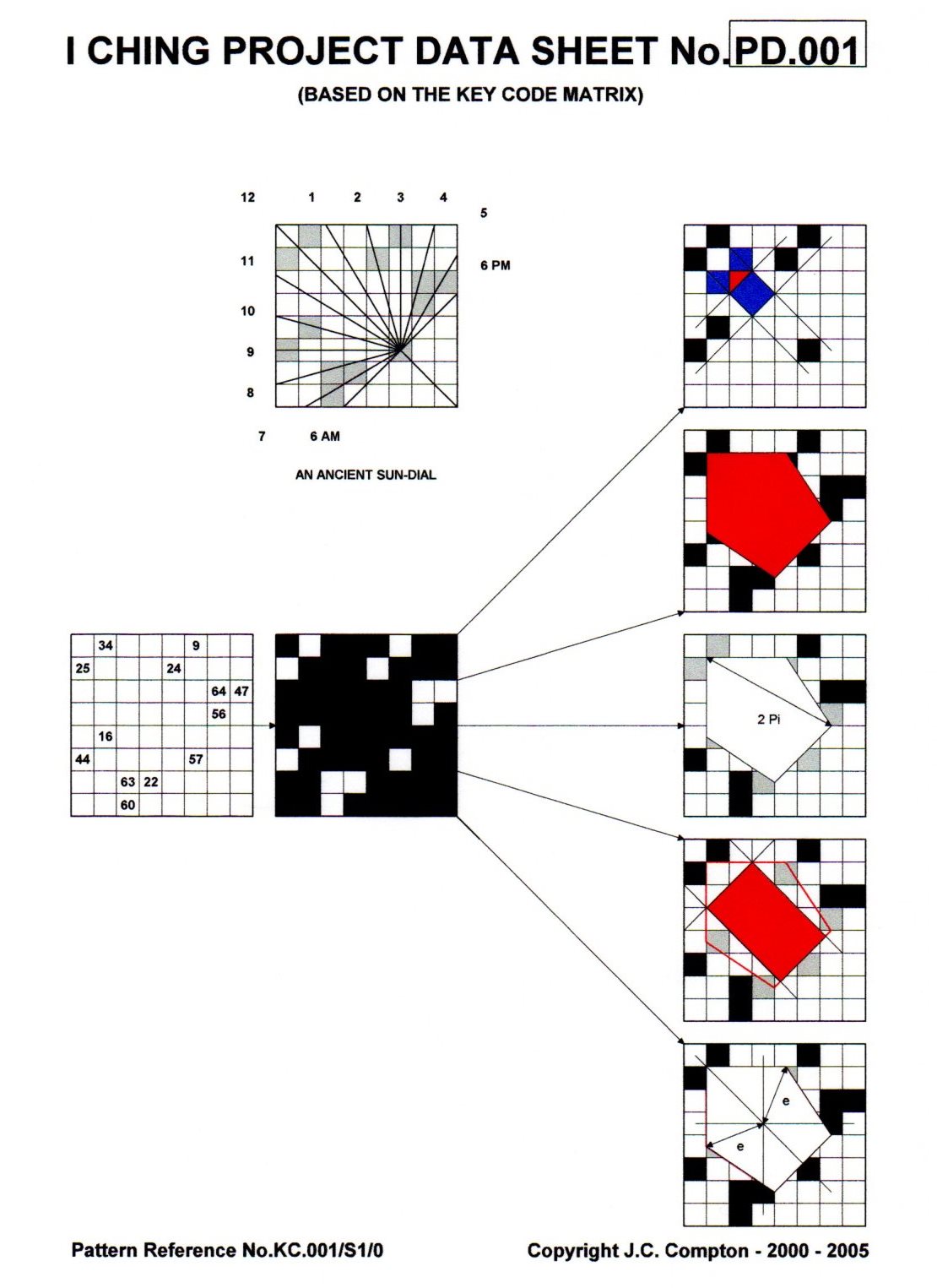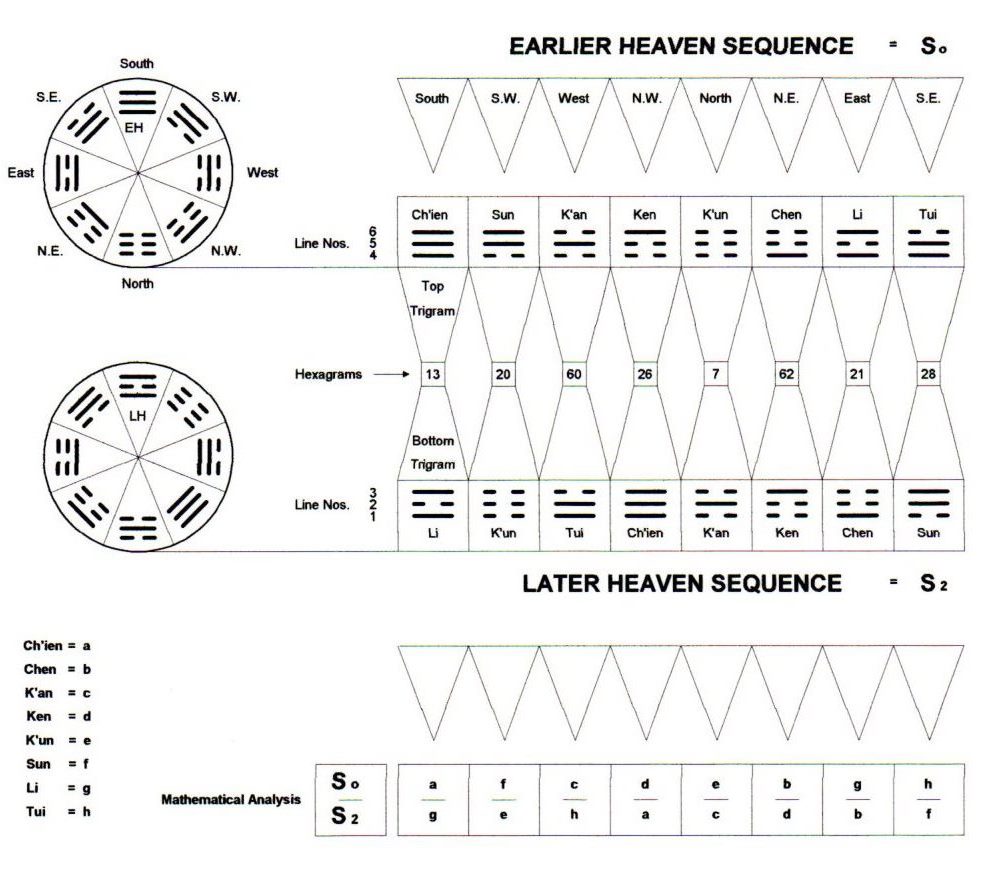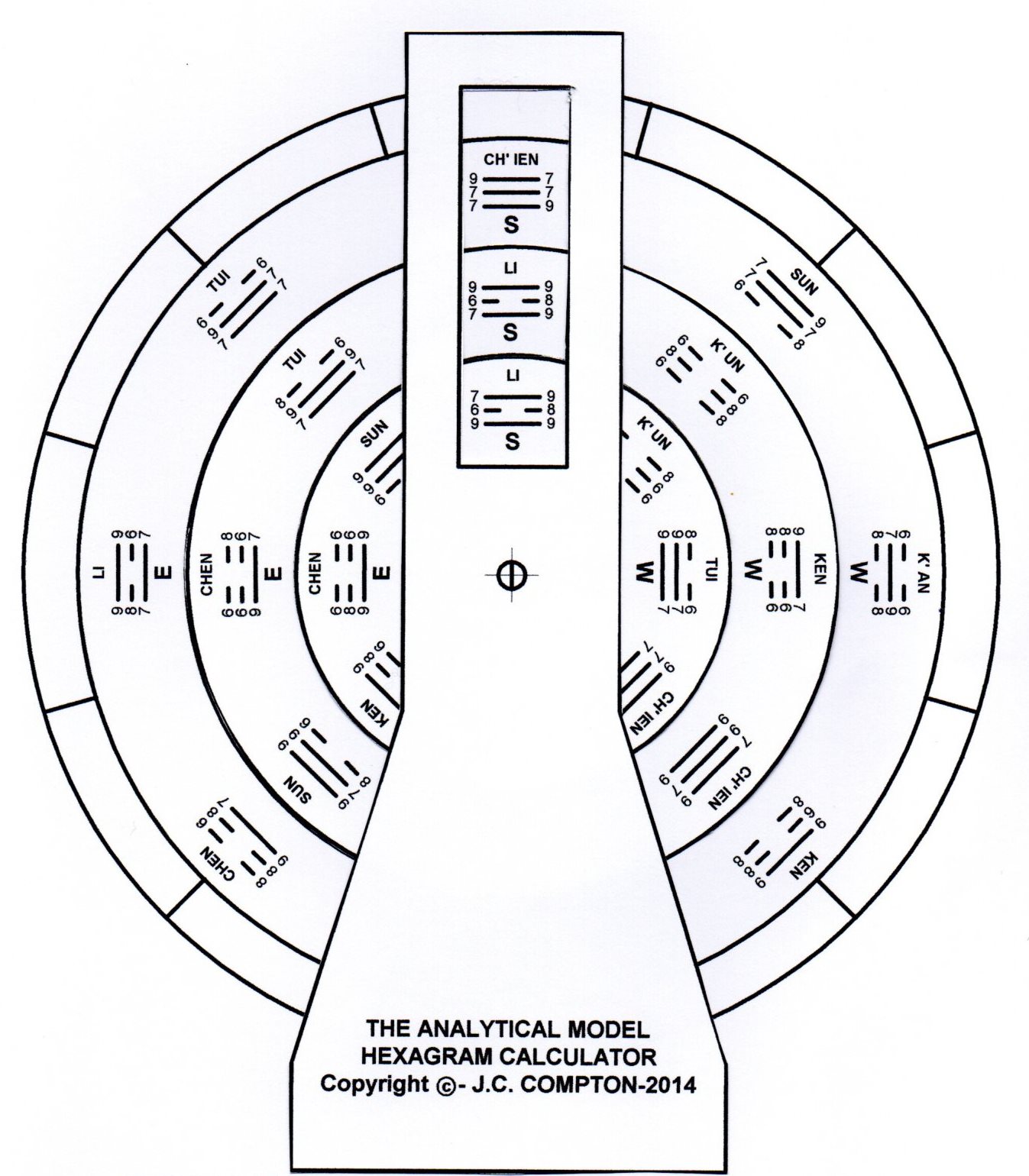They are often referred to as Trigram Disks or Discs, where the data is encoded in a symbolic format, unlike the modern day floppy diskettes where data is encoded magnetically. In the ‘static’ mode shown here, represented by the trigrams of
each sequence aligned to their respective cardinal compass point position, only 16 hexagrams can be created (eight of which are shown). Plus an additional eight formed by reversing the position of the trigrams from each respective sequence, i.e. placing the bottom trigrams at
the top and the top trigrams at the bottom.
In the ‘rotation’ mode, where one disk is rotated whilst the other one is stationary, a larger number of
hexagrams may be created. However, the initial mathematical criteria developed for the analysis was designed for disks in the ‘static’ mode,
which expressly forbid the use of the ‘rotation’ mode.
It was obvious, that more than two trigram disks were required to obtain a meaningful result and as
such additional disks became a necessity.
Note: I considered that the primary criteria for the ancient I Ching computer system design would be -
To create the maximum number of hexagrams for the minimum number of trigram disks. My research has proved that the ‘rotational’ mode could be
used by the adoption of a number of rules that governs trigram transition and numerical line notation.
The system that has evolved is a three disc system. It utilizes two reference discs and one program disc.
Reference discs are normally stationary, whilst program discs are designed to rotate in either the clockwise or anti-clockwise direction.
This methodology enables a larger number of hexagrams and variable mathematical / combinatory regimes to be created. This was achieved by the
simple inter-action of trigrams, when the cardinal compass point alignment of trigrams occurs.
This methodology also proved that the ancient encrypted codes of the I Ching could be mathematically
resolved as one of choice and selection of individual trigrams from three different cyclic sequences. However, this was an extremely difficult
task because one has to decide which trigram from which cyclic sequence should be chosen to create a specific hexagram.
This problem was resolved by the discovery of an unusual trigram template, which had remained hidden
within the binary text of the I Ching itself. This template forms the essential central processing unit (C.P.U.) of the I Ching computer system.
It was originally designed to extract symbolic data, by selecting individual trigrams from the program and reference trigram discs, in order to
create a series of hexagrams by utilizing combinatory mathematics.
It effectively pre-selects specific trigrams from all three trigram discs simultaneously at each specific cardinal compass point position.
Thus, the methodology employed enabled several series of hexagrams to be created in a repeatable uniform mathematical and scientific manner.
Details of this C.P.U. will be made available to interested parties at a later date.
2. Divinatory
Readings
Divinatory Readings of the I Ching are normally
obtained by use of the Yarrow Stick or Coin Oracle methods,
where the random selection of one of the sixty-four readings is
determined by the construction of a hexagram symbol. In addition
to these two oracle methods, hexagrams may also be created from
two trigrams, by simply placing one trigram over the other.
There are eight different trigram symbols and by combining two
trigrams together, a combinatory series of sixty-four hexagrams
may be formed.
3. Trigram Discs
Two circular trigram arrangements are illustrated in most
books of the I Ching. These are known as the Earlier Heaven and
Later Heaven Arrangement . Very little information is given as to their purpose or use. The consensus of opinion, from a number of authors and
researchers of the I Ching, is that they are Magic Charms, which
have no real intrinsic or use what so ever. It was thought that
they belonged to yet another ancient oracle system which may
have employed the use of fixed and spinning discs similar to
those used for the Tibetan Prayer wheels or the German Enigma
coding machine.
4. The Analytical Model Calculator
In order to prove that trigram discs formed part of an
ancient computer system and to determine the technical
feasibility of such an arrangement, a model hexagram calculator
was constructed which utilized three circular trigram
arrangements. The model consists of three individual discs of different
radii, attached to each other via a central axis pin, which
permits each disc to rotate. The circumference of each disc is segmented into eight equal sections,
the periphery of which is inscribed with the following data.
- The trigram symbol.
- The respective cardinal compass point position of the
trigram.
- The associated clockwise and anti-clockwise numerical
line values of each trigram line.
Each disc represents a different
trigram arrangement. The model was so designed so that the
respective cardinal compass point alignment of each trigram
would enable the practitioner to select two adjacent trigrams
each from a different disc, in order to create a hexagram by
simply placing one trigram over the other. With the discs in a
static mode, a large number of different hexagrams were created by utilizing various
mathematical combinatory movement patterns for the selection of
individual trigrams.
5. The Initial
Results
It had been anticipated that the hexagram
calculator, with the discs in a static mode, would at some point
replicate and produce every single hexagram of the I Ching.
However, this was not the case. Thirteen anomalous
hexagrams had eluded the combinatory series of movement patterns
which had been mathematically pre-determined during the initial
design of the calculator.
It was obvious that the deficiency of the hexagram
production was due to either: A miscalculation of the combinatory mathematics, or alternatively, the use of only three trigram arrangements, where the diverse nature of the
sequential trigrams were insufficient in order to replicate the complete series of Sixty-four hexagrams.
6. Disc Rotation
Disc rotation was considered. It was however initially
rejected, primarily because the trigram alignment of each disc
to its respective cardinal compass point position was considered
to be of some importance for reference purposes. (It should be noted that a disc rotation method would only
require one fixed and one moving disc, each inscribed with all
eight trigram symbols to effectively create all sixty-four
hexagrams by mathematical permutation).
Further research was carried out later, after the Rules for
disc rotation and associated logic truth tables had been
developed. These rules were applied to the resultant hexagrams
produced by the analytical model. The disc rotation method
created hexagrams by the instantaneous alignment of two
adjacent trigrams which were selected from two different
discs. This instantaneous alignment of trigrams has been termed
an instantaneous Causal Event
as change occurs
at that moment in time.
Over nine hundred hexagrams were produced in this manner. The
prime criteria for an instantaneous causal event was the
instantaneous formulation of a hexagram, whose combined binary
value of both trigrams matched the binary value of the
respective hexagram mentioned in the I Ching text. The number of
hexagrams which met this criteria was therefore
significantly reduced to sixty-four. These instantaneous
hexagrams were then segregated into groups and the resultant
pictographic images obtained are as shown below on Project Data
Sheet PD001.

16. Final Conclusion
Research has conclusively proved that the originators of the I Ching:
Invented, developed and used the Binary Digital Code over 3000 years ago.
Understood and had an in-depth knowledge of Amino Acids and the Genetic Code.
Knew the basic components of Nuclear Physics.
Developed a mathematical system of numbers which encompassed everything in the Universe.
The I Ching is a book that relies on self knowledge. It
gives mankind an insight into the minds of the scribes of an
ancient civilization, by showing us in a pictographic manner
their thoughts, ideas, inventions and wisdom.
It is concluded, that a considerable amount of mathematical
information is encoded within the strange symbolic trigram
discs. The examination of a number of acquired archaeological
discs and other religious artefacts, has shown that it is not
necessary for the practitioner to obtain every disc, in order to
complete the project work.
With the exception of a few unique and different discs, which
incorporate two or more than two trigram symbols of the same
type (by omitting other trigrams), all trigram disc arrangements
can be determined by using combinatory mathematics.
The
Computer System of the I Ching, has revealed an ancient time
capsule of pictographic images. It will take many years to
decipher the thousands of images which lay hidden within its
mystical symbolism.
Preview of The - H - System Model Hexagram Calculator
Important Note:
The Pages
shown herein form part of the I Ching Project Documentation and
are presented in this document for reference purposes only.
No part of these Project Data Sheets
may be reproduced or utilized in any form or by any
means, electronic or mechanical, including photocopying,
recording or by an information storage and retrieval system
without the permission in writing from the Author.
Page 1: The I Ching H System - Position South
Page 2: The I Ching H System - Position South West
Page 3: The I Ching H System - Position West
Page 4: The I Ching H System - Postion North West
Page 5: The I Ching H System - Position North
Page 6: The I Ching H System - Position North East
Page 7: The I Ching H System - Position East
Page 8: The I Ching H System - Position South East
Copyright © John C. Compton
- 2006 - 2013


